It was moved to the site where a large hotel was torn down in 1974
Brochure
1900 of Our Cottage History
Bob Jensen at
Trinity University
This is our
cottage after it was moved in 1977 from the edge of the Sunset Hill Resort Golf
Course
It was moved to the site where a large hotel was torn down in 1974
This picture
was taken of our cottage just after the move from the golf course
The bowling alley had not yet been torn down
The small building to the right of the bowling alley was the Power House
It is now part of our barn
The original driveway and tennis court are now grassed over
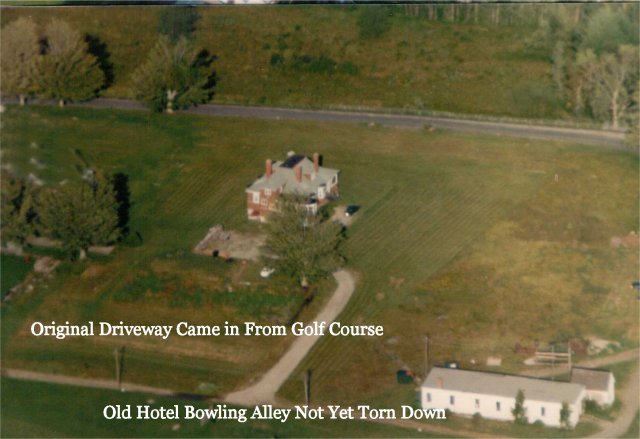
The eastward
view toward the White Mountains is now our parlor view
This was at one time the view from the main hotel's dining room
This is a picture of Mt. Washington taken from my desk on the front porch
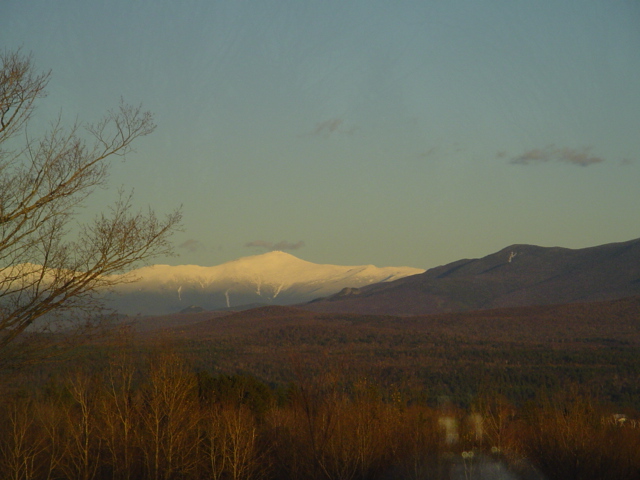
Our cottage
was at one time the golf clubhouse called the Pavilion (because of its oriental
roof style) in the 1800s
Then it became the Pavilion Tennis Clubhouse in the early 1900s
It later became one of three VIP "housekeeping cottages" that hotel guests could
rent with housekeeping services
The cottage was smaller in those days without the garage and master bedroom added after
the 1977 move from the golf course
The middle cottage eventually burned down and the cottage on the far end remains
alongside the golf course

The middle VIP cottage burned down after our cottage was moved
These are
some aerial views of the Sunset Hill Hotel Resort (1880-1973) before it was torn down
At peak capacity the main hotel, annex, and cottages could handle 340 guests for lodging and dining
At one time the resort had its own power house, casino, bowling alley, swimming pool,
and golf course
There were red-roof barns for the carriage horses that took guests to and
from the train depot
There were also barns for the resort's dairy cows and vegetable farming
equipment
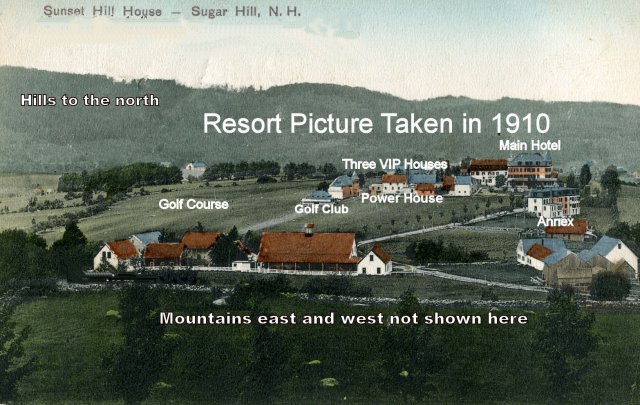
Update in
2014
20-Year Sugar Hill Master Plan ---
http://www.nccouncil.org/images/NCC/file/wrkgdraftfeb142014.pdf
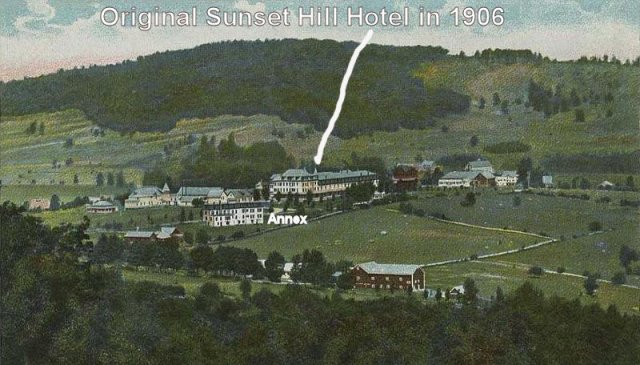
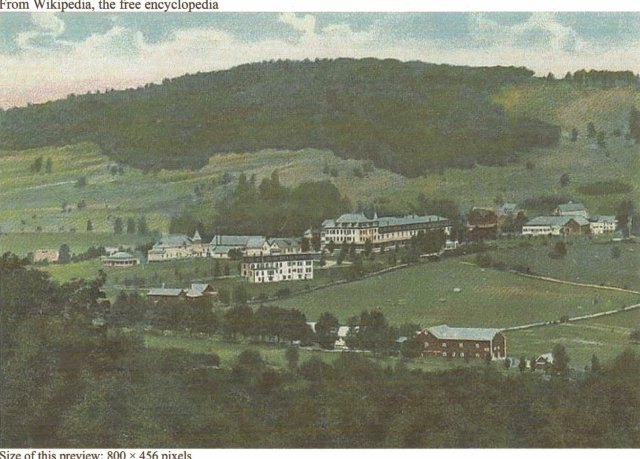
The main hotel was torn down in an interesting manner in 1974. Each room was
sold at auction
and a buyer of a room could take everything from the room, including the
furniture, fixtures, windows, and floors.
The remaining structure was then burned down along with most surrounding
buildings.
Buildings remaining to date include two of the three VIP cottages, the power
house (my barn), the
golf clubhouse, and the Annex which was eventually renovated to become the
current
Sunset Hill House Hotel.

A neighbor, Susan Packard, now lives in one of the three original VIP
cottages and makes fine jewelry.
Susan kindly loaned me an old brochure that I think (without being certain) was
printed before 1900
My only date clue is Page 22 of the brochure where women on the golf course were
still wearing skirts down to the ground

Below is an 1881 Post Card Showing the Main Hotel of the Resort

Below is an 1892 Post Card of the West Side of the Main Hotel



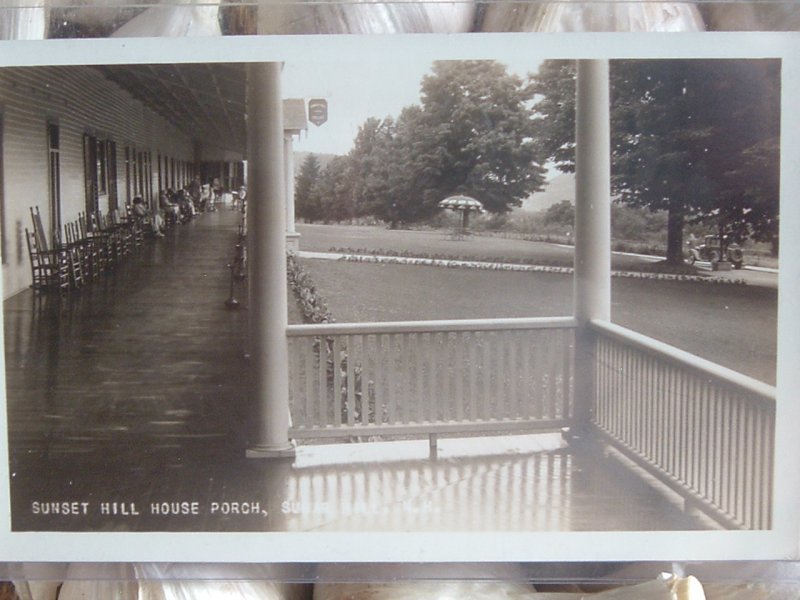
The pictures below are from that old brochure
The logo SHH stands for Sunset Hill Hotel
Sunset Hill itself in Sugar Hill is a ridge between New Hampshire's White Mountains to the
east and Vermont's Green Mountains to the west

Page 2 of the brochure shows an eastward view of the backside of the SHH resort complex.
In the background are
Mt. Lafayette, Mt. Lincoln, Franconia Notch, Cannon Mountain, and the Three Graces
(Cannon Ball) Mountains
The church in the foreground is what is now known as our Sugar Hill Community
Church with pastor Ned Wilson

Page 3 and ensuing pages of the brochure

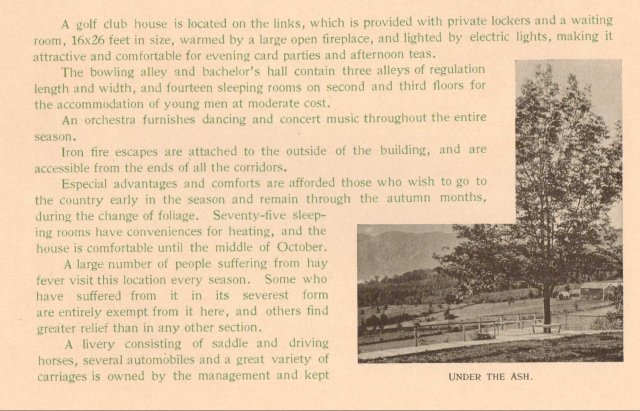
St. Matthew's Episcopal Chapel a half mile north still has weekly summer services
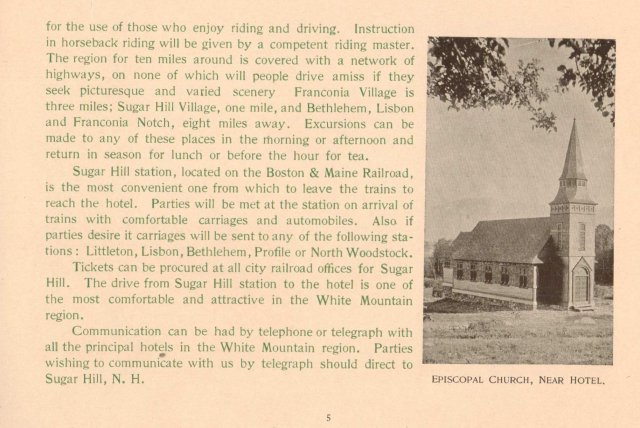


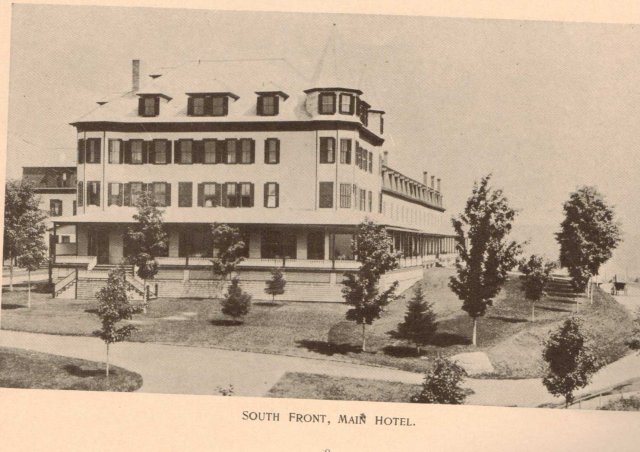



The Sugar Hill Train Depot still stands in Lisbon, NH
Sugar Hill and Lisbon were a single rural community and widely-spread for miles at one time in history
Then there was an acrimonious split into two communities where Lisbon is a more
traditional small
town
And Sugar Hill Village is mostly a spread-out rural community without a
commercial downtown or schools
Before horseless carriages, SSH guests would arrive by train and be taken in
horse-drawn carriages to either the SSH Resort or
one of the similar resorts in Sugar Hill, including the
Lookoff Hotel
Resort and the older
Peckett's-On-Sugar-Hill Resort
where film star Bette Davis visited before buying the nearby Butternut Farm ---
http://facuolty.trinity.edu/rjensen/tidbits/2007/tidbits070801.htm
Guests were taken by horse carriages from the Lisbon or Sugar Hill Train Depots


The Annex is where selected employees and some guests of the SSH Resort were lodged
The Annex was not torn down when most of the SSH Resort buildings were
razed in 1974
The Annex later was refurbished into what now is the current Sunset Hill House
Hotel and Golf Course
Under Ore Hill beyond the Annex is a boarded up mine where iron ore was once
packed on mules
and carried down to Franconia Village where fine Franconia Stoves were
manufactured ---
http://facuolty.trinity.edu/rjensen/tidbits/2007/tidbits070924.htm


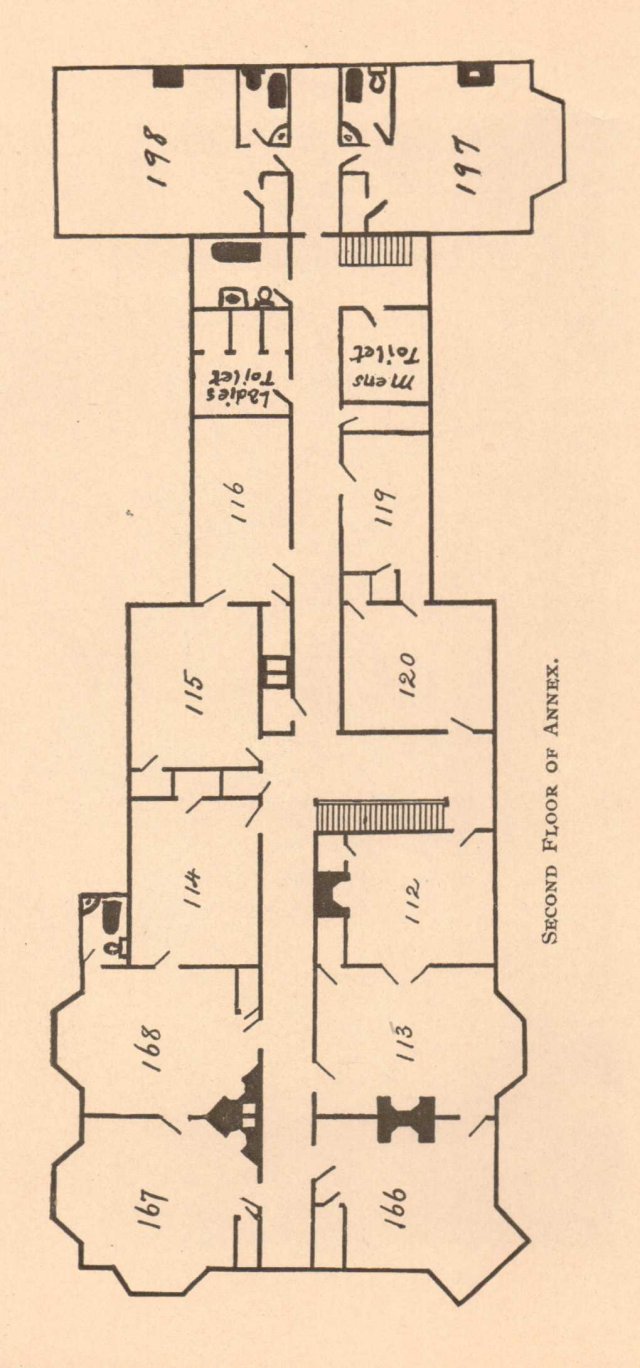

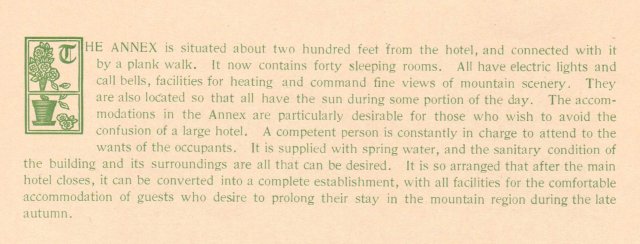
The three VIP summer cottages were built alongside the golf course in the 1900s
Note that our cottage had an open porch in those days
After the 1977 move of this cottage the porch was closed in with curved glass windows
The glassed-in front porch is now part of our parlor

At some point the Pavilion Cottage was purchased by Mrs. Brayton and became
known as the Brayton Cottage
I don't think she owned the land underneath the cottage and had resort
privileges
After the main hotel was torn down the land, Brayton Cottage, and the Power
House were purchased
by George Foss. In 1977 George moved the Brayton Cottage and its four fireplaces
to the site of the main hotel.
He placed it on a great full basement and added a double garage and master
bedroom and an outdoor studio.
One of the old bedrooms was converted into the master bathroom which has one of
the
few commodes in America sitting smack dab in front of a full fireplace.
Erika and I purchased Brayton Cottage and the Power House (my barn) in 2003 from
George Foss

The building below still serves
as the golf course clubhouse
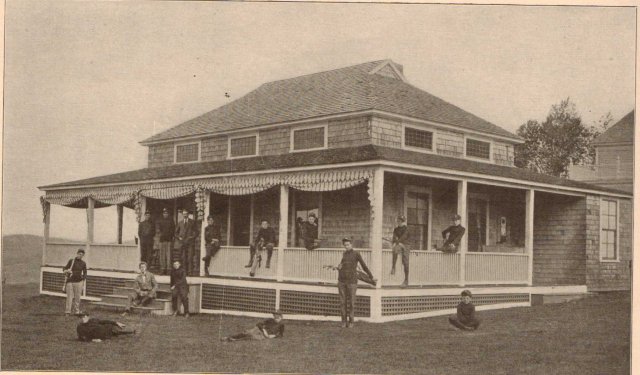

The SSH Resort raised its own
vegetables and milked its own cows for fresh milk

This is the last page of the
brochure

Below is a picture of the Lookoff Hotel that I scanned from a postcard loaned to
me by Dr. Clapp
The Lookoff Hotel was about a half mile up the hill from the SSH Resort
The Three Graces mountains north of Mt. Kinsman are visible in the background
The Sugar Hill Community Church is visible in the foreground
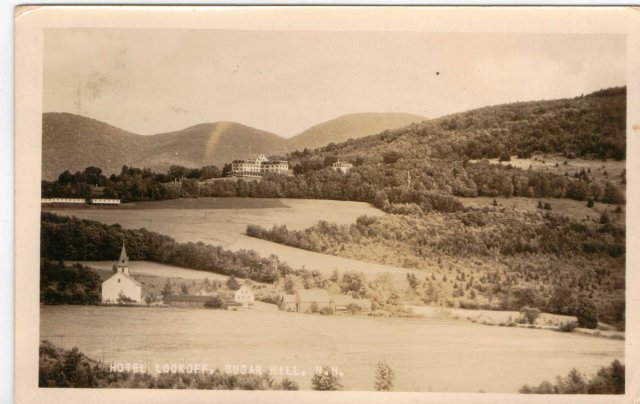
Question
Why did these grand resorts of New England and Canada play out in the latter
half of the 20th Century after thriving for 100-200 years in the windy
mountains, cold lakes, and on the Atlantic Ocean's shore?
Jensen Comment
Over 95% of these grand resorts were torn down or burned down in the latter half
of the 20th Century. This begs the question about why these thriving resorts met
their demise. In nearby Bethlehem, NH there were 14 such huge hotels. Today all
14 have either disappeared or are boarded up.
Reasons for the beginning of the end are numerous and complicated. But one of the main causes was the invention of effective building air conditioning. Before AC, women and children escaped from the sweltering heat of big cities in the east, south, and even cities in the Midwest like Chicago and St. Louis. Husbands and fathers frequently visited on long weekends via a vast network of passenger trains that ended in places like the Sugar Hill Station.
Other major reasons for the demise of the big summer resorts of the northeast included improvements in automobiles and roads. Painstakingly slow Model T Fords were prone to breakdowns and flat tires on unpaved and rutted mountain roads. Eventually fast cars with amazing tires were whizzing over paved roads at over a mile-a-minute. New roads were opened up to real estate in the windy mountains, cold lakes, and on the Atlantic Ocean's shore. People not only commenced to build second homes for summer retreats and winter skiing, they built such places as investments in booming real estate markets following World War II.
Families in urban centers commenced to favor touring vacations instead of fixed-in-place resorts. What became especially popular and still is popular is for mom and dad to drop their kids off for a few weeks in summer camps in New England and then to tour like honeymooners to other parts of New England and Eastern Canada.
Some causes of demise of these resorts were interactive. With the greatly improved automobiles and roads came the decline in passenger rail service upon which New England's grand old resorts depended upon for customers. Although train travel remained the most comfortable and efficient way to travel from Baltimore to Sugar Hill Station, there was not enough daily demand year around along the way to keep passenger rail service profitable. Workers commenced to use their cars to get to and from their jobs in places like Pittsfield, MA, Hartford, CN, and Manchester, NH. Passenger trains serving such working towns became unprofitable, especially in the face of union featherbedding and wage demands.
In the meantime, costs increased dramatically for these labor-intensive grand
old resorts. World War II changed the labor markets dramatically. Women could
now leave their chambermaid jobs for careers in factories and offices. Minimum
wage laws were enacted ---
http://en.wikipedia.org/wiki/Minumum_wage
And the old hotels themselves were becoming outdated relative to changed lifestyles. Hotel guests no longer wanted to go back and forth down the hall to "water closets" shared by other guests. Television and fast food replaced nightly dining and dancing and conversations on porches and verandas. Lifestyles became too fast-paced for rocking chair living.
Towering business hotels started being built in big cities under such names as Hilton, Hyatt, Marriott, and Sheraton. In 1944 near the end of World War II, Stalin, Churchill, and Roosevelt met with the world's leading economists and bankers in New Hampshire's grand old Mount Washington Hotel. It was quite a journey by train for these heads of state and leading economists and world bankers to travel from major airports to Bretton Woods, NH. In more modern times these busy executives would prefer to meet in luxury air conditioned hotels much closer to the international airports --- http://en.wikipedia.org/wiki/Bretton_Woods_Conference
A few if New Hampshire's historic resorts have survived. These include:
- Mount Washington Hotel (since 1902)--- http://en.wikipedia.org/wiki/Mount_Washington_Hotel
- Mountain View Grand Resort and Spa (since 1866) --- http://www.mountainviewgrand.com/
- The Balsam's Grand Resort Hotel (since 1895) --- http://en.wikipedia.org/wiki/Balsams_Grand_Resort_Hotel
The days of the above surviving resorts are probably numbered. Costs of maintaining these historic structures according to hotel codes of today are out of sight. Costs of labor and insurance are astronomical. Families willing to spend $5,000 on a luxury vacation now opt for cruise ships and tours of Europe, Asia, Australia, and New Zealand.
Pricing in the old days was somewhat interesting. Costs were often less that $5
per day for room and board instead of $500 per day ---
Click Here
http://books.google.com/books?id=85Y-AAAAYAAJ&pg=PA6&lpg=PA6&dq=%22Lakes+and+Summer+Resorts+in+New+Hampshire%22&source=bl&ots=vb3zaU51W0&sig=hsohYs-CbUII8g34IhF-NExoA9c&hl=en&ei=Y3eATp_TA4Pe0QGyoMkU&sa=X&oi=book_result&ct=result&resnum=2&ved=0CGYQ6AEwAQ#v=onepage&q&f=false
And today there are no dance orchestras playing each and every evening
these days.
But 1800-1960 was a wonderful era for New England and Canadian historic luxury resorts while it lasted.
Some of Bob Jensen's Pictures and Stories
Bob Jensen at Trinity University
Cottage
Set 01 of my cottage pictures --- http://faculty.trinity.edu/rjensen/NHcottage/NHcottage.htm
Set 02 inside the cottage --- http://www.cs.trinity.edu/rjensen/Tidbits/2009/Tidbits090723.htm
Set 03 inside the cottage --- www.trinity.edu/rjensen/Tidbits/Cottage\Inside/Set03/Set03InteriorCottage.htm
Set 04 inside the cottage --- http://www.cs.trinity.edu/rjensen/Tidbits/Cottage\Inside/Set04/Set04InteriorCottage.htm
Photographs of Putting a New Rubber Roof Under Our Widow's Walk
http://cs.trinity.edu/rjensen/Tidbits/CottageHistory/WidowsWalk/WidowsWalk.htmIndoor Plants --- http://www.cs.trinity.edu/rjensen/Tidbits/IndoorPlants/IndoorPlantsFavorites.htm
Amaryllis --- http://www.cs.trinity.edu/rjensen/Tidbits/2008/Tidbits080212.htmThe Inn on Sunset Hill (just down from our cottage) ---
https://www.youtube.com/watch?v=A5cqUX0LcbU&t=9s
Cottage History
Sunset Hill House Resort History Set 01 ---
http://faculty.trinity.edu/rjensen/tidbits/CottageHistory/Hotel/Brochure/Brochure1900.htmHistoric Photographs (Set 01) of the Sunset Hill House Resort Shared by Gunsmith Ron Resden from Vermont
http://www.cs.trinity.edu/rjensen/Tidbits/Resden/01ResdenSSH.htmHistoric Photographs (Set 02) of the Sunset Hill House Resort Shared by Gunsmith Ron Resden from Vermont
http://www.cs.trinity.edu/rjensen/Tidbits/Resden/02ResdenSSH.htmHistoric Photographs (Set 03) of the Sunset Hill House Resort Shared by Gunsmith Ron Resden from Vermont
http://www.cs.trinity.edu/rjensen/Tidbits/Resden/03ResdenSSH.htmAfter the Sunset Hill House Resort was nearly all demolished in 1973, our cottage (before it was ours)
was moved in 1977 from the golf course across a tennis court and up to where the former hotel site.
I show pictures of the preparation work prior to the moving the cottage and its four fireplaces
http://faculty.trinity.edu/rjensen/Tidbits/CottageHistory/OldSite/Set01/Set01.htmNext I show pictures of the move to the new site
http://faculty.trinity.edu/rjensen/Tidbits/CottageHistory/NewSite/Set01/Set01.htmNext I show the pictures of a 1890 spectacular fire on one of the remaining three cottages
www.trinity.edu/rjensen/tidbits/CottageHistory/Fire/FireSet01.htmIron Ore --- http://www.cs.trinity.edu/rjensen/Tidbits/2007/Tidbits070924.htm
Sunset Hill House Hotel: The American Dream ---
http://www.cs.trinity.edu/~rjensen/temp/SunsetHillHouse/SunsetHillHouse.htmPart 1 of the History of the Homestead Inn Torn Down in 2015
http://faculty.trinity.edu/rjensen/Tidbits/Hotels/Homestead/Set01/Set01.htmPart 2 of the History of the Homestead Inn
http://faculty.trinity.edu/rjensen/Tidbits/Hotels/Homestead/Set02/Set02.htm
More of Bob Jensen's Pictures and
Stories
http://facuolty.trinity.edu/rjensen/Pictures.htm
Blogs of White
Mountain Hikers (many great photographs) ---
http://www.blogger.com/profile/02242409292439585691
Especially note
the archive of John Compton's blogs at the bottom of the page at
http://1happyhiker.blogspot.com/
Question
Are there trails in our White Mountains of New Hampshire that have ice in summer
as well as winter?
See "The Ice Gulch, Would I do it Again" by John Compton, August 5, 2011 ---
http://1happyhiker.blogspot.com/2011_08_05_archive.html
Okay, you might ask, is there really ice in the Ice Gulch, even in August? Yes, there is! The next photo shows one small patch of ice. There were many larger patches, but they were at the bottom of some of those deep gaps that I mentioned above. I took some photos, but none of them really turned out, even with using a flash to illuminate these dark, dank, deep spots.
White Mountain News --- http://www.whitemtnews.com/
On May 14,
2006 I retired from
Trinity University after a long and
wonderful career as an accounting professor in four universities. I was
generously granted "Emeritus" status by the Trustees of Trinity University. My
wife and I now live in a cottage in the White Mountains of New Hampshire ---
http://facuolty.trinity.edu/rjensen/NHcottage/NHcottage.htm
Bob
Jensen's Blogs ---
http://facuolty.trinity.edu/rjensen/JensenBlogs.htm
Current and past editions of my newsletter called New
Bookmarks ---
http://facuolty.trinity.edu/rjensen/bookurl.htm
Current and past editions of my newsletter called
Tidbits ---
http://facuolty.trinity.edu/rjensen/TidbitsDirectory.htm
Current and past editions of my newsletter called
Fraud Updates ---
http://facuolty.trinity.edu/rjensen/FraudUpdates.htm
Bob Jensen's past presentations and lectures
---
http://facuolty.trinity.edu/rjensen/resume.htm#Presentations
Our
address is 190 Sunset Hill Road, Sugar Hill, New Hampshire
Our cottage was known as the Brayton Cottage in the early 1900s
Sunset Hill is a ridge overlooking with
New Hampshire's White Mountains to the East
and Vermont's
Green Mountains to the West
Bob Jensen's Threads --- http://facuolty.trinity.edu/rjensen/threads.htm
Bob Jensen's Home Page --- http://facuolty.trinity.edu/rjensen/